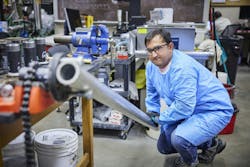Boomer! University of Oklahoma joins Los Alamos in Work on Carbon Storage Hub
A team of researchers from across the University of Oklahoma Mewbourne College of Earth and Energy and Los Alamos National Laboratory have secured an $18.7 million grant from the U.S. Department of Energy to investigate commercial subsurface storage of CO2.
The university and national lab will work with industry partners, including oil and gas firms, on the Oklahoma Carbon Hub project. The sites under development could involve partner companies operating just outside the Sooner state.
The Oklahoma Carbon Hub is part of the U.S. Department of Energy's Carbon Storage Assurance Facility Enterprise (CarbonSAFE) initiative and a $518 million effort by the DOE's Office of Fossil Energy and Carbon Management to fund a third round of projects focused on carbon storage site characterization and permitting.
"We're emitting more and more carbon dioxide into the atmosphere over time. If we could capture that carbon dioxide at certain point sources, we could use these types of facilities to store it long-term,” Matthew Pranter, director of the OU School of Geosciences and the lead principal investigator on the grant, said in a statement. “With this grant and the Mewbourne College of Earth and Energy's history of expertise in the subsurface, OU will be able to directly impact and participate in reducing CO2 emissions into our atmosphere. We're trying to help with the global issue of climate change and mitigate or reduce the amount of CO2 that's going into the atmosphere."
Read EnergyTech's full coverage of carbon capture projects
The project will investigate three separate sites in Osage and Kay Counties as potential locations for the injection of approximately 54 million metric tons of CO2 over 20 years. For reference, the average car in the U.S. will produce one metric ton of CO2 over a three-month period.
The CVR fertilizer plant near Coffeyville, KS, the Azure sustainable aviation fuel production facility near Cherryvale, KS, and the Heimdal direct air capture units on the Osage Reservation in Oklahoma will store CO2 emissions through the Hub.
According to Matthew Pranter, Ph.D., director of the OU School of Geosciences and Eberly Family Chair, the lead principal investigator on the grant, subsurface geological storage is a potentially favorable option as oil and natural gas under the surface have been trapped for years and have not migrated to the surface.
For these potential sites, researchers contend it is important to characterize and quantify the spatial distribution of pore space and minerals in the subsurface and determine the optimal locations to drill injection wells.
A crucial aspect of the project is drilling wells to acquire thick cores to provide researchers direct observation of the rock. The target rock layer is the Arbuckle Group, a primarily limestone and dolomite formation.
Pranter added that the Arbuckle Group in the study area has high porosity, while the rock formations above have low porosity and permeability, predicted to act as a seal to keep the stored CO2 in the Arbuckle Group. Porosity is the percentage of void space within a rock, allowing for potential storage within the rock formation. Permeability defines how easily that a material can flow through the pores of the rock.
About the Author
EnergyTech Staff
Rod Walton is head of content for EnergyTech.com. He has spent 17 years covering the energy industry as a newspaper and trade journalist.
Walton formerly was energy writer and business editor at the Tulsa World. Later, he spent six years covering the electricity power sector for Pennwell and Clarion Events. He joined Endeavor and EnergyTech in November 2021.
He can be reached at [email protected].
EnergyTech is focused on the mission critical and large-scale energy users and their sustainability and resiliency goals. These include the commercial and industrial sectors, as well as the military, universities, data centers and microgrids.
Many large-scale energy users such as Fortune 500 companies, and mission-critical users such as military bases, universities, healthcare facilities, public safety and data centers, shifting their energy priorities to reach net-zero carbon goals within the coming decades. These include plans for renewable energy power purchase agreements, but also on-site resiliency projects such as microgrids, combined heat and power, rooftop solar, energy storage, digitalization and building efficiency upgrades.
